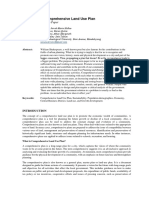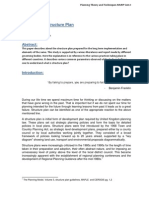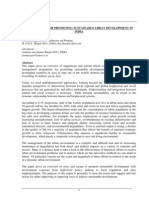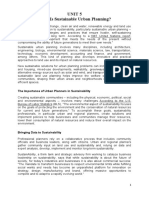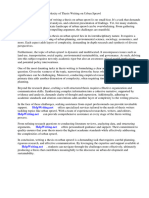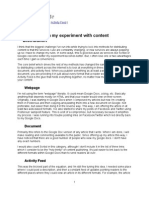PPS1 - Delivering Sustainable Development
PPS1 - Delivering Sustainable Development
Uploaded by
Kevin ChanCopyright:
Available Formats
PPS1 - Delivering Sustainable Development
PPS1 - Delivering Sustainable Development
Uploaded by
Kevin ChanOriginal Title
Copyright
Available Formats
Share this document
Did you find this document useful?
Is this content inappropriate?
Copyright:
Available Formats
PPS1 - Delivering Sustainable Development
PPS1 - Delivering Sustainable Development
Uploaded by
Kevin ChanCopyright:
Available Formats
SUSTAINABLE DEVELOPMENT
PPS1 Delivering sustainable development Land use planning regulation SOCIAL COHESION Equal opportunities for all Partnership working (RDAs > LEPs) Sustainable mix of housing Sex, ethnic background, religion, income
Social Cohesion > In all service sectors/civil servants create equal opts regardless of origins, so to speak. Create equality in education, retail access, fair infrastructure and transport, work for a common vision toward Health and a SENSE OF BELONGING. Institutionalize a local level of citizen leadership lead toward citizen governance, where local people are placed centre stage in policy formulation and service delivery (and then collaborate from the bottom up) enrol in more town/ward meetings. More fulsome understanding of planning at a local level, so everyone can contribute to plan making. Not to be totalitarian about it, avoid un-productive rioting even though it is a means of scathing government bureaucracy/ now that the bureaucracy is being exploited in favour of MNCs, we are immersed in a big business state, to the point some places have been offered Advocacy development frameworks. For example, John Lewis council starting to implement services in Lambeth offering tax rebates/ pensions, argued by humanitarians saying a corporate capitalist structure detracts from normative interactions. E.g. kids growing up lose touch of humane physical abilities, become over-comfortable with the technological advances. So implement walking-buses to help understand the physicality of places, encourage Steiner Schools of thought, make CITIZENSHIP part of the curriculum is schools (maximise the capacity for demographic of age groups, employ psychologists to disseminate the ideas of children and propagate them unto the place making agenda) This will integrate a dialogue of human rights and responsibilities. To understand the importance of removing barriers, such problems existing are within the integration of migrants (social studies can tell you it is very limited i.e. language barriers of new arrivals) Training programs to access skilled jobs/ Sure Start PROTECT AND ENHANCE ENVIONMENT Environment of both rural and urban Enhance amenities High level protection for valued landscapes SSSI , AONB, Heritage sites Positive look on public spaces
Protect and Enhance Environment. Environmental issues implicate a polluter pays approach! Directly afflict corporations, who lobby against environmental affairs in their laissez faire capitalist ways. Considerations:
Mitigation of effects Reduction in greenhouse gases Air quality and land contamination Noise/Light pollution (not sure if I agree with this one from a local/bottom up view) Conservation/ enhance wildlife / biodiversity Avoid new development on areas of flood risk unless correct infrastructure can be implemented
PRUDENT USE OF NATURAL RESOURCES Use wisely / sustainable consumption Ensure outputs are maximised Do not endanger resources Promote energy efficient buildings/ sustainable water use
Prudent Use of Natural Resources. Use factorial saving materials, smarter materials (better output) i.e. Biomimicry innovation at the Eden Project i.e. propagate the R&D making use of nature. LED lights save 51 tonnes of CO2 emissions each year. Also the insulating polymer membrane which is 100x lighter than glass, a self-heating / passive solar design Implement clever design materials into the way we urbanise our cities (the near future holding possibilities such as nanotechnology and biomimicry) we could call this environmental sprawl as part of physical development. Consolidate positive attitudes towards private sector bodies and proliferate a bottom up structure, in my eyes and principally the most solid structure. SUSTAINABLE ECONOMIC DEVELOPMENT PPS12 Strong, Safe and Prosperous Community Planning Key bottom up role, through elected local leadership Reflect the Planning and Compulsory Act 1947 (encourage more dev/abide by leg) Manipulate : Voice ideas though community pluralism : less bureaucracy To inform LDF and Core Strategy
INTERGRATE SUST. DEV. IN DEVELOPMENT PLANS Be sensitive toward: Social inclusion Enhancing environmental design/development In turn this will generate economic/social dev (employment/humanity)
Local communities to recognise economic development RDAs abolished and LEPs formed, bring together public and private and third sector bodies. Coalition cut QUANGOS & merge beneficial ones// proliferate innovation in services, not just through new technologies but through artistic approaches reflecting the importance of humanity. E.g. assessable live music (The Old Duke) / street art (Nelson Street)
Influence LAA on a 3 year plan. Enhance the local authoritys partnership on the LSP. Implement delivery mechanisms for Sustainable Community Strategies (SCS) EXCERPT The economic development model based on the increased urbanisation, deforestation, predominance of private car use (only for private sector working high rollers?) against public transport, unplanned tourism and industrial development, uneven consumption of water and goods between different regions, has led to a dramatic environmental and ecological degradation of the planet. A major impact of human intervention in climate change which is not just of scientific interest but is a reality felt in every country of the world. We are living in an accelerated technological era of rapid global changes which afflict climate change. Health. Local spatial planning is a pre-requisite for sustainable development at every level (each needing collaborating leadership/institution so there is maximum awareness. The city may require a publically elected Governor. LOCAL, NATIOAL, GLOBAL. LDF>BRISTOL CORE STRATEGY 1947 town and country planning act all new development needs planning permission. Subsequently, Local Planning Authorities and LOCAL POLICY BODIES were made to form Local Development Frameworks. To decide place making on LAND & changes of use (mainly on Brownfield sites) LPA of Bristol = Bristol City council other regions broken down into: Bath & North East Somerset, Bristol City Council, North Somerset, South Gloucestershire Partnership on a wide scale is prioritized in Transport & Housing as MAJOR infrastructure planning decisions are to be place-made
LDF
Development Document Plans (required) Core Strategy Site Specific Allocations Area Action Plans Other Development Plan documents Supplementary Planning Docs (SPD) Local Development Scheme Project Plan Statement of Community Involvement Annual Monitoring Rapport Masterplans Development Briefs
*Rigorous consultation required, 2 to 3 year turn Must be adopted after receipt of binding inspectors report scraped in the Localism Bill
*Rigorous consultation required, Expand policies, provide additional details Can be site specific, but not allocate land Community Strategy
Bristol Civic Society supports much of the Bristol Core Strategy Publication Version, and recognises the Councils urgent need to replace the Bristol Development Plan (1998). We comment only on the soundness of the document, as required at this stage of the planning policy process. The society recognises that the Core Strategy is high-level policy, which leaves the detail to other Local Development Scheme documents. However, in the Societys view, the Core Strategy is unsound if it lacks a programme to create local area character-specific development plans, because it fails to demonstrate a reasoned justification of the strategy. We believe that government guidance supports this view. Paragraph 4.2, of PPS 12, states the need for planning to deal with the unique needs and characteristics of places. Paragraph 4.5 of PPS 12 says: It is essential that the core strategy makes clear spatial choices about where developments should go in broad terms. In the Societys view, the Core Strategy would become sound if it included a programme to obtain evidence to produce a succession of local area action plans. Only local plans can show how the Core Strategy can deliver 9,000 new homes in the central areas, 10,000 in south Bristol, 2,000 in the Inner East area and 3,000 in the Northern Arc (the regeneration areas). Without such plans, the Core Strategy will not demonstrate that: (i) the regeneration areas have the capacity to absorb the new homes (ii) the local settings of the new homes will satisfy the national place-making policy to build distinctive local sustainable communities within a comprehensive city-wide spatial strategy. (iii) it can deliver the Core Strategys indispensable employment, mixed use and green infrastructure targets. The Core Strategy would be sound if it includes an agreed programme of a sequence of Area Action Plans. Residents will then understand the vision for their neighbourhood because they will play their part in the plans production. Developers will be certain of the outcome of planning process. The Council will be in the best position to stand by its plans because of the status of the Area Action Plan in development management. Because the areas suitable for AAPs would lie in regeneration areas identified with public involvement, the Society believes a further round of public consultation that would delay the Local Development Scheme would be unnecessary. The Area Action Plan (AAP) An AAP is a more effective planning tool to deliver planning policy than a Supplementary Planning Document or a Masterplan. When adopted, the AAP becomes part of the planning framework. The SPD and Masterplans status is limited to the category, planning advice.
New rights and powers for communities Greater freedom and flexibilities for local government are vital for achieving the shift in power the government wants to see. But, on their own, these measures will not be enough. Government alone does not make great places to live, people do. People who look out for their neighbours, who take pride in their street and get involved - from the retired teacher who volunteers in the village shop once a month, to the social entrepreneur who runs the nursery full time.
Until now, however, many people have found that their good ideas have been overlooked and they have little opportunity to get on and tackle problems in the way they want. Voluntary and community groups often find that their potential contribution is neglected, when, in fact, they carry out some of the most innovative and effective work in public services and we should be encouraging them to get more involved. We want to pass significant new rights direct to communities and individuals, making it easier for them to get things done and achieve their ambitions for the place where they live. Community right to challenge The Government thinks that innovation in public services can offer greater value for taxpayers money and better results for local communities. The best councils are constantly on the look out for new and better ways to design and deliver services. Many recognise the potential of social enterprises and community groups to provide high-quality services at good value, and deliver services with and through them.
In some places, however, voluntary and community groups who have bright ideas find that they do not get a proper hearing. The Localism Bill will give these groups, parish councils and local authority employees the right to express an interest in taking over the running of a local authority service. The local authority must consider and respond to this challenge; and where it accepts it, run a procurement exercise for the service in which the challenging organisation can bid. This will make it easier for local groups with good ideas to put them forward and drive improvement in local services. Community right to buy (assets of community value) Every town, village or neighbourhood is home to buildings or businesses that play a vital role in local life. They might include meeting rooms, swimming pools, village shops, markets or pubs. Local life would not be the same without them, and if they are closed or sold into private use, it can be a real loss to the community. In many places across the country, when local amenities have been threatened with sale or closure, community groups have taken them over. In some cases, however, community groups who have attempted to take assets 9over have faced significant challenges. They often need more time to organise a bid and raise money than the private enterprises bidding against them. Proposals in the Localism Bill will require local authorities to maintain a list of assets of community value. Communities will have the opportunity to nominate for possible inclusion the assets that are most important to them. When listed assets come up for sale or change of ownership, community groups will have time to develop a bid and raise the money to buy the asset when it comes on the open market. This will help local communities keep much-loved sites in public use and part of local life. Local referendums In many other countries around the world, communities have the right to put any local issue to a local vote. The ability to trigger a referendum can enliven local democratic debate and give people a way of making their voice heard on the issues that are close to their heart. Currently, in this country, communities can only trigger a local referendum in limited circumstances, and on a very limited range of questions. The Localism Bill will give local people the power to initiate local referendums
on local issues that are important to them. Local authorities and other public bodies will be required to take the outcome of referendums into account and consider what steps, if any, they will take to give effect to the result.
Right to approve or veto excessive council tax rises Local government derives a significant proportion of its revenue from council tax. The money raised through council tax is spent on supporting vital local services. But it is important that council tax is set at a rate which has the support of local people, and that their taxes are carefully managed by authorities on their behalf. Currently, central government has the power to cap council tax rises. If Ministers think that local authorities are increasing taxes excessively they can stop them doing so. But we think that local people should decide whether to accept an excessive council tax increase. The Localism Bill will therefore give local communities the power to decide. The Secretary of State will determine a limit for council tax increases which has to be approved by the House of Commons. If an authority proposes to raise taxes above this limit they will have to hold a referendum to get approval for this from local voters who will be asked to approve or to veto the rise. This means that local authorities will need to convince local voters, rather than central government of the case for excessive rises in council taxes.
5 KEY SUSTAINABILITY ISSUES 5.1 A number of key sustainability issues, which the Core Strategy should look to address, were identified from analysis of the baseline data. These were used to inform the alternative options for achieving spatial growth, refinesustainability objectives and guide consideration of the significance of sustainability effects during the appraisal process.
6 SUMMARY OF OPTIONS 6.1 At the Issues and Options stage officers within the Strategic and Citywide Policy team identified different options that were realistic and achievable ways of meeting the objectives of the Core Strategy. These options were informed by: the key sustainability issues set out above, the issues set out in the Core Strategy Issues Paper (November 2006) comments from stakeholders in response to consultation on the Core Strategy Issues paper (July 2007). 6.2 The identification of alternative options at this stage of the process resulted in 3 overall spatial options and a number of development principles which focused only on policy areas where it was felt there were realistic achievable alternative options. The policy options in the Core Strategy Issues and Options Paper were appraised against the sustainability objectives, and negative or positive effects were predicted. 6.3 The findings from this stage of the appraisal informed the choice of Preferred Core Strategy Options, based on an understanding of broad predicted negative and positive effects on sustainability in Bristol.
You might also like
- Community Planning: An Introduction to the Comprehensive Plan, Second EditionFrom EverandCommunity Planning: An Introduction to the Comprehensive Plan, Second EditionRating: 3 out of 5 stars3/5 (1)
- Open Space Strategies - Best Practice GuidanceDocument71 pagesOpen Space Strategies - Best Practice Guidancewnock49No ratings yet
- Australia's Unintended Cities: The Impact of Housing on Urban DevelopmentFrom EverandAustralia's Unintended Cities: The Impact of Housing on Urban DevelopmentNo ratings yet
- Live in Grace, Walk in Love: A 365-Day JourneyDocument4 pagesLive in Grace, Walk in Love: A 365-Day JourneyNina ForeelNo ratings yet
- Draft National Planning Policy Framework: Community, Opportunity, ProsperityDocument65 pagesDraft National Planning Policy Framework: Community, Opportunity, ProsperityEarlswood LakesNo ratings yet
- Neighbourhood Planning For Metropolitan Brisbane: Putting Planning Into PracticeDocument10 pagesNeighbourhood Planning For Metropolitan Brisbane: Putting Planning Into Practiceapi-287692413No ratings yet
- Easier To Read Summary - Draft National Planning Policy FrameworkDocument12 pagesEasier To Read Summary - Draft National Planning Policy FrameworkEarlswood LakesNo ratings yet
- A Community Comprehensive Plan Serves The Following FunctionsDocument5 pagesA Community Comprehensive Plan Serves The Following FunctionsJanePasongNo ratings yet
- Introduction To Urban PlanningDocument77 pagesIntroduction To Urban PlanningAMANUEL WORKUNo ratings yet
- Sustainable Communities Lecture NineDocument16 pagesSustainable Communities Lecture NineM Hammad ManzoorNo ratings yet
- 14 Chapter 11 ConclusionDocument5 pages14 Chapter 11 ConclusionSustainable Neighbourhoods NetworkNo ratings yet
- Government Planning Organizations and Environmental PlanningDocument17 pagesGovernment Planning Organizations and Environmental PlanningPeña ,Khlarenze G.No ratings yet
- Draft How To Guide PDF FormatDocument67 pagesDraft How To Guide PDF FormatJeannie ThamNo ratings yet
- Preamble: NUR UYUN BT. AMAN / 0530108 Professional Planning Practice / Aup 4265Document6 pagesPreamble: NUR UYUN BT. AMAN / 0530108 Professional Planning Practice / Aup 4265uyunamanNo ratings yet
- Sample NoteDocument13 pagesSample NoteFathima sona MNo ratings yet
- Comprehensive Development Plan For LGUDocument4 pagesComprehensive Development Plan For LGUNeil Geraldizo DagohoyNo ratings yet
- Strategic Urban PlanningDocument11 pagesStrategic Urban PlanningDivine Grace FernandoNo ratings yet
- Planning-Term-Paper (Final) Clup by GroupDocument10 pagesPlanning-Term-Paper (Final) Clup by GroupAbbey Margareth EvangelistaNo ratings yet
- Plan PDFDocument93 pagesPlan PDFAlvinTiteNo ratings yet
- Housing and Its Relationship With Neighborhood and City PlanDocument18 pagesHousing and Its Relationship With Neighborhood and City PlanPiyush TNo ratings yet
- Structure Plan PDFDocument8 pagesStructure Plan PDFAbhishek Jani100% (1)
- An Overview For Promoting Sustainable Urban Development in IndiaDocument9 pagesAn Overview For Promoting Sustainable Urban Development in IndiaSandeep NayarNo ratings yet
- An Overview For Promoting Sustainable Urban Development in IndiaDocument9 pagesAn Overview For Promoting Sustainable Urban Development in IndiaSandeep NayarNo ratings yet
- National Framework For Physical PlanningDocument15 pagesNational Framework For Physical PlanningDongzkie Vainkill100% (1)
- Neighbourhood PlanningDocument17 pagesNeighbourhood PlanningViKas SaketNo ratings yet
- 2013 Green Infrastructure Li Position StatementDocument32 pages2013 Green Infrastructure Li Position StatementKarliane MassariNo ratings yet
- Urban and Regional PlanningDocument28 pagesUrban and Regional PlanningChristine AloyaNo ratings yet
- Execs UmDocument15 pagesExecs UmEsttie Radam100% (1)
- All About Introduction To URPDocument36 pagesAll About Introduction To URPFaria HossainNo ratings yet
- GSC CLUP 2018-2026 Volume 1 - CLUPDocument253 pagesGSC CLUP 2018-2026 Volume 1 - CLUPcotiadanielNo ratings yet
- Legal Instruments & Guiding Frameworks For Planners: A ReportDocument7 pagesLegal Instruments & Guiding Frameworks For Planners: A ReportbarkhabaharNo ratings yet
- Technical Assistance Consultant's ReportDocument34 pagesTechnical Assistance Consultant's ReportFrialynNo ratings yet
- Development PlanDocument8 pagesDevelopment PlanuyunamanNo ratings yet
- Envi Planning Key ConceptsDocument72 pagesEnvi Planning Key ConceptsRosanne SelorioNo ratings yet
- What Is Urban PlanningDocument11 pagesWhat Is Urban PlanningCyril Kaye DolorzoNo ratings yet
- Urban Environmental ManagementDocument6 pagesUrban Environmental Managementunderthearch.studioNo ratings yet
- 1496 Lesson Text Version PDFDocument10 pages1496 Lesson Text Version PDFMarie Cris Gajete MadridNo ratings yet
- Manthan Topic: Future Cities: Ensuring World Class Civic Amenities in Urban IND "Document18 pagesManthan Topic: Future Cities: Ensuring World Class Civic Amenities in Urban IND "Jayjeet BhattacharjeeNo ratings yet
- Unep 21-22Document16 pagesUnep 21-22fdr.marcelloNo ratings yet
- UCLG Global Agenda Outline PDFDocument9 pagesUCLG Global Agenda Outline PDFRizal OctoNo ratings yet
- d7d275ef-0364-4d2c-80fb-902c6a2f3a1aDocument5 pagesd7d275ef-0364-4d2c-80fb-902c6a2f3a1aYana ArsyadiNo ratings yet
- Crafting A Theoretical Framework On Waste ManagemeDocument8 pagesCrafting A Theoretical Framework On Waste ManagemeXENOPHILIUSNo ratings yet
- Assignment 5Document24 pagesAssignment 5Mary Claire CandelariaNo ratings yet
- Urban Design PolicyDocument23 pagesUrban Design Policyदीपक दासNo ratings yet
- UntitledDocument6 pagesUntitledkmitchell@mhsmarchitectsNo ratings yet
- Comment: Draft NEP 2004: A Flawed VisionDocument9 pagesComment: Draft NEP 2004: A Flawed Visionapi-3833989No ratings yet
- What Is Sustainable Urban PlanningDocument3 pagesWhat Is Sustainable Urban PlanningKouame AdjepoleNo ratings yet
- Nat Res Assign 2Document2 pagesNat Res Assign 2Jhanelyn V. InopiaNo ratings yet
- Satargmni 3 2021 08 04Document2 pagesSatargmni 3 2021 08 04ლელა ვერბიNo ratings yet
- Concept of Regional PlanningDocument4 pagesConcept of Regional PlanningPankaj Pharswan100% (1)
- Sustainability 2 CEconomics 2 Cand UrbanizationDocument39 pagesSustainability 2 CEconomics 2 Cand UrbanizationSOFIA YVONNE ZANONo ratings yet
- Types of Urban Planning ConceptDocument7 pagesTypes of Urban Planning ConceptEljean Mae MagaladNo ratings yet
- Hu AssignmentDocument32 pagesHu Assignmentkartiksharma90972No ratings yet
- RSW No. 6 - Javier, Danica T.Document33 pagesRSW No. 6 - Javier, Danica T.DaNica Tomboc JavierNo ratings yet
- Technical Proposal NUSP2 PROJECT: NEIGHBORHOOD UPGRADING AND SHELTER PROJECT - (PHASE 2)Document13 pagesTechnical Proposal NUSP2 PROJECT: NEIGHBORHOOD UPGRADING AND SHELTER PROJECT - (PHASE 2)Tiar Pandapotan PurbaNo ratings yet
- Planningforthepublic Finaldraftupload3Document19 pagesPlanningforthepublic Finaldraftupload3luzmastercollegeNo ratings yet
- Comprehensive Planning TemplateDocument21 pagesComprehensive Planning TemplateErnan BaldomeroNo ratings yet
- RTPI Manifesto For Planning 2010 FullDocument16 pagesRTPI Manifesto For Planning 2010 Fullbeto7373No ratings yet
- Sustainable Future Cities We WantDocument13 pagesSustainable Future Cities We WantMonika TanushevskaNo ratings yet
- Thesis On Urban SprawlDocument4 pagesThesis On Urban Sprawltsfublhld100% (1)
- Building a Multimodal Future: Connecting Real Estate Development and Transportation Demand Management to Ease GridlockFrom EverandBuilding a Multimodal Future: Connecting Real Estate Development and Transportation Demand Management to Ease GridlockNo ratings yet
- PCM ProblemsDocument25 pagesPCM ProblemsSrilatha LadellaNo ratings yet
- Method StatementDocument4 pagesMethod StatementSheeraz AliNo ratings yet
- APJ Abdul Kalam PDFDocument1 pageAPJ Abdul Kalam PDFshreyasi senNo ratings yet
- Information SystemsDocument4 pagesInformation Systemssha chandraNo ratings yet
- Renold Giunti Cat Gen Eng PDFDocument96 pagesRenold Giunti Cat Gen Eng PDFInformational kya kaiseNo ratings yet
- BEE Assignment Unit 4Document13 pagesBEE Assignment Unit 4Abhishek RaoNo ratings yet
- LSG-E SeriesClamping Force 35 ~ 950Togglels乐星注塑机Document17 pagesLSG-E SeriesClamping Force 35 ~ 950Togglels乐星注塑机1648183658No ratings yet
- UTLAPPE Slow Rolling Turbine Best PracticeDocument10 pagesUTLAPPE Slow Rolling Turbine Best PracticeAleem QureshiNo ratings yet
- Bagaimana Mewujudkan Smart Hospital Di Indonesia 1Document22 pagesBagaimana Mewujudkan Smart Hospital Di Indonesia 1Abdul NasirNo ratings yet
- VisiLogic Software Manual-Function BlocksDocument194 pagesVisiLogic Software Manual-Function BlocksCristiano SoderNo ratings yet
- TAIM WESER Test EquipmentDocument1 pageTAIM WESER Test EquipmentBenny YacilaNo ratings yet
- Abener: Optimization Techniques in Engineering and Construction of A Bioethanol PlantDocument14 pagesAbener: Optimization Techniques in Engineering and Construction of A Bioethanol PlantWael_Barakat_3179No ratings yet
- AlphaParts Kouimtzis Catalogue 2017Document147 pagesAlphaParts Kouimtzis Catalogue 2017Sven De VosNo ratings yet
- Firefighter Jeopardy 4Document62 pagesFirefighter Jeopardy 4Fire LibraryNo ratings yet
- An Update On My Experiment in Content Distribution #ProhoDocument4 pagesAn Update On My Experiment in Content Distribution #ProhoJ.A.MorganNo ratings yet
- CM SLMDocument828 pagesCM SLMGirarza100% (1)
- Sulphur Hexafluoride (SF6) Circuit BreakerDocument4 pagesSulphur Hexafluoride (SF6) Circuit BreakerVishal BhatNo ratings yet
- Development CommunicationDocument115 pagesDevelopment CommunicationPrakash PrabhakarNo ratings yet
- Varian 2100SC Linear Accelerator: Treatment InnovationDocument2 pagesVarian 2100SC Linear Accelerator: Treatment InnovationbearcaNo ratings yet
- SOW Template 071905Document4 pagesSOW Template 071905Karen ThongNo ratings yet
- Chinese BridgeDocument2 pagesChinese BridgeVico DanielNo ratings yet
- 1l7vb415e1 MZ300 Bara0Document22 pages1l7vb415e1 MZ300 Bara0Vikas ChandraNo ratings yet
- Fuel Retention Sample ContainersDocument2 pagesFuel Retention Sample ContainersSarbast H. SaeedNo ratings yet
- Arvind Mills LTDDocument15 pagesArvind Mills LTDChetan PanaraNo ratings yet
- Acxiom Case Study - MicrosoftDocument2 pagesAcxiom Case Study - MicrosoftsilentwarrioronroadNo ratings yet
- AP CP: SM-G570M Block DiagramDocument43 pagesAP CP: SM-G570M Block DiagramkikeNo ratings yet
- 5 Ways FabricDocument7 pages5 Ways FabricSilvia PinhoNo ratings yet
- HV Outdoor CVTDocument6 pagesHV Outdoor CVTReji KurianNo ratings yet
- Catálogo Danfoss e Vickers - Bombas e Motores de Palheta V VQ V10 V20 VMQ VQ (H)Document4 pagesCatálogo Danfoss e Vickers - Bombas e Motores de Palheta V VQ V10 V20 VMQ VQ (H)Schumacher Centro Hidráulico e AutomotivoNo ratings yet

















